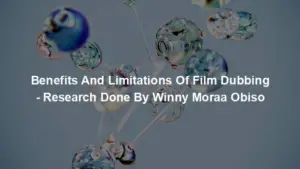Translation Techniques For Differences Between Languages.mp3 transcript powered by Sonix—easily convert your audio to text with Sonix.
Translation Techniques For Differences Between Languages.mp3 was automatically transcribed by Sonix with the latest audio-to-text algorithms. This transcript may contain errors. Sonix is the best audio automated transcription service in 2020. Our automated transcription algorithms works with many of the popular audio file formats.
The dubbing King Software presents. Translation techniques for differences between languages. A comprehensive guide. What our translation techniques, translation techniques are used when structural and conceptual elements of the source language can be transposed into the target language. Borrowing, taking words straight into another language. Also known as transfer. Why do we need to employ different translation techniques? Translation techniques enable effective communication between people around the world. It is a courier for the transmission of knowledge. A protector of cultural heritage and essential to the development of a global economy. Highly skilled translators, Akis helped practitioners develop those skills. When a professional translator sits down to work, he or she does not stop and think about the strategies to be employed for a particular translation work. It comes spontaneously. But ask a translator to make a list of the translation techniques they use, and they might be hard pressed to describe these to an outsider. Nevertheless, I will pinpoint these techniques to help readers interested in translation to learn more about the many nuances of this interesting work that well, deserves public awareness and attention. A translator considers many elements before the actual translation is done. There could be discrepancies in vocabulary and grammar in both languages. That means literal translation is not possible. That is why these translation techniques are used to come up with an accurate translation. Broadly, there are two main translation types, direct and oblique, with subtypes under each one. It should be noted that translation techniques are different from translation methods.
Translation methods are applied to the entire document translation technique. On the other hand, can vary within the same document based on the particular verbal elements that require translation. What are the different translation techniques? Direct translation techniques. Direct translation techniques are utilized when the conceptual and structural elements of the source language SL are directly transferable into the target language. T. L. The techniques used for direct translation are borrowing. Calkin literal translation. In borrowing, the words are taken directly from the source language into the target language without any translation. Such as funk technology, abattoir, Persay Cafe, resumé, hamburger and bandana. Often these words are italicized to indicate that they are foreign words. Also known as loan translation, it means a phrase that is borrowed from another language and literally translated, such as Superman and Biergarten from the German words and the German stand punkt becomes standpoint in English. Kalki can be seen often in international land. Specialized fields such as Quality Assurance or ASIC gourami entered Akali DARD in Spanish. The meanings of some counts are not that clear to other people, especially when they relate to law, science and other vocations. Often the translator will be creating coined words in the target language by adopting the source languages structure as in handball. English becoming Balón Mano in Spanish. Rasca Cee Lo's Spanish and Grot SEAL French means skyscraper in English. Literal translation. Word for word or literal translation, metter phrase is applicable to some languages, but not for others due to the difference in the structure of the sentences.
For example, in the English sentence, the team is working to finish the report. The literal translation in Spanish is Alky Polestar Tropp, our Hando Para term Menar Alien for me. But this sentence cannot be literally translated into German or French because of the differences in sentence structure. It is normally applied only to languages that are very close to each other culturally and is only acceptable if the same syntax, style and meaning are maintained in the translated text are bleak. Translation techniques when the conceptual or structural elements of the source language cannot be directly translated into the target language without changing its stylistic and grammatical elements and the meaning, oblique translation techniques are used here. The translator exerts tighter and stricter control over their translation. This category has five types. One in modulation, a phrase that is not the same as the SL. A.l is used to impart the same idea. The Spanish phrase Tayloe de ho literally translates to I leave it to you. However, it sounds better when translated as you can have it. It changes the meaning and switches the source languages point of view. Modulation can also be used without changing the meaning and putting in awkwardness in the target language. It is also possible to imply modulation in the same language. In this example s fa sealed went in there and no accomplis. Kado did.
Entin Damián. It is easy to understand and it is not complicated to understand respectively. The former indicates that something is not difficult to comprehend, whereas in the latter the meaning goes deeper by saying that something was previously thought of as difficult, but turns out to be not a complicated thing to understand too. This is when the sequence of some parts of the speech changes. For example, yellow ball in English becomes ballet ün in French. This is because grammatical structures could be different in some languages. For example, a famed Gan in German is he likes swimming in English. Transposition is also employed often when translating English into Spanish and vice versa. Because of verb positioning in Spanish, the verb is positioned near the end of the sentence, while in English the verb is quite close to the beginning. Thus, the translator must know that a word category can be replaced in the T. L. without changing the essentials, meaning three equivalence or reformulation. When translating advertising slogans, interjections, proverbs, names of institutions and idioms. Oftentimes the expression must be translated in an entirely different manner. In this case, equivalence or reformulation is used. This process is a bit difficult and creativity is essential. For example, it is easy for Americans and other English speakers to understand the saying, don't put all your eggs in one basket. However, directly translating this phrase might not have the same meaning in other languages, thus substituting it with the phrase Keep your options open makes it easier to understand in more languages.
For generally speaking, compensation applies to terms that cannot be translated. Yet their nuances are expressed somewhere else within the text. In English there is only the pronoun you, for example, whereas there are informal and formal versions in French too, and VOO in German do and see and in Spanish to understand. The degree of formality is expressed in several ways, which is not present in English when using comp.. The translator exercises discretion and some freedom in replacing elements that are inherent in the source language with items that are native to the target language. A translator who uses compensation techniques must have a deeper knowledge of the source and target languages, as well as the ability to have a higher level of understanding that goes beyond literal translation. Five. This is used when a term or phrase that is specific to culture is translated in a completely different manner so that it becomes appropriate or familiar to another culture's language in adaptation. The cultural reference to a situation is changed if this is not existent in the target culture. Like substituting Belgian jokes with Irish jokes when translating from French to English, it is quite commonly used in the translation of movie titles and books as well as in pop culture. Conclusion. Have you ever tried to use an online translator and did not understand the resultant translation? If this has happened to you, you will understand the difficult task of coming up with a fully comprehensible and accurate translation in the language that you understand and the fact that human translators are needed to produce quality translations.
Professional translators employ many elements, skills, knowledge and techniques that are available and required in their profession. One of the main things is the deep understanding of the source and target languages. Many of the techniques discussed here will be applied in different parts of the document. Literal translation may still need a bit of tweaking to make it sound better. In the translated language, verbs may be repositioned and idioms may have to be changed or replaced to fit the culture of the reader. Translators are very sensitive to cultural issues and exercise sound judgment to change phrases, terms and sentences that might be offensive to other cultures. When you require accurate translation, do not rely on machines as they are not capable of producing accurate translations. Translation work is a combination of many elements. The work process is difficult and long and must conform to various rules which are indigenous to most languages. For example, English to Spanish translation might not need a lot of changes to be implemented, although it cannot be said that it is still easy. Consider. Translation from English to Arabic. English to Hindi. English too Afrikaans or English to Chinese and vice versa. Being a good translator is not an inherent skill. It requires long periods of study and on the job experience.
Automatically convert your audio files to text with Sonix. Sonix is the best online, automated transcription service.
Sonix uses cutting-edge artificial intelligence to convert your mp3 files to text.
Create better transcripts with online automated transcription. Automated transcription is much more accurate if you upload high quality audio. Here's how to capture high quality audio. Manual audio transcription is tedious and expensive. Do you have a podcast? Here's how to automatically transcribe your podcasts with Sonix. More computing power makes audio-to-text faster and more efficient. Automated transcription can quickly transcribe your skype calls. All of your remote meetings will be better indexed with a Sonix transcript. Rapid advancements in speech-to-text technology has made transcription a whole lot easier. Sometimes you don't have super fancy audio recording equipment around; here's how you can record better audio on your phone.
Sonix uses cutting-edge artificial intelligence to convert your mp3 files to text.
Sonix is the best online audio transcription software in 2020—it’s fast, easy, and affordable.
If you are looking for a great way to convert your audio to text, try Sonix today.
Other Podcasts

Why Use A Professional Voice Over For Your Explainer Video? – Research Done By Everline Moragwa Achira
Listen Now »


